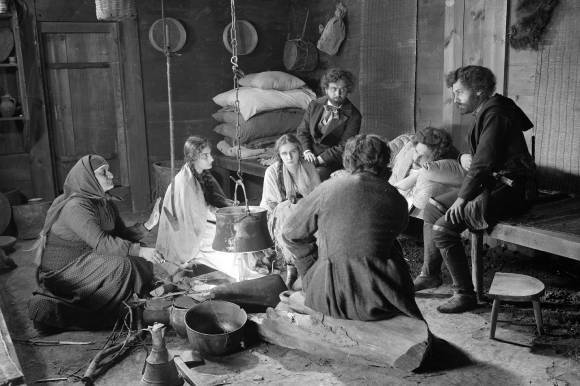Film Heritage remains one of the key priorities of the GNFC. The films could not be delivered from Moscow's massive Gosfilmofond archives in 2020, due to the pandemic. Nevertheless, the technical works (restoration) are going on continuously. Up to 60 feature films have been submitted at this stage. To date, 23 of them have been restored, and this number will increase to 34 by the end of the year.
The Georgian National Film Center (GNFC) declared 2020 the year of the 1920s cinema. Despite the epidemic situation, eight films from the 1920s brought from the Russian film archives Gosfilmofond were restored, in cooperation with the National Archives: Gogi Ratiani (1927) and The Gadfly (1928) by Kote Marjanishvili, Who is to Blame (1925), Revolt in Guria (1928) by Aleksandre Tsutsunava, Arsena the Outlaw (1923) by Vladimir Barsky, Saba (1929) by Mikheil Tchiaureli, Eliso (1928) by Nikoloz Shengelaia and The Young Pilot (1928) by Nikoloz Kakhidze.
"After the Sovietisation of Georgia, the Menshevik government of the country had to emigrate politically. Most Georgian artists tried getting used to the Bolshevik government. During the Russian Empire and four years of Georgia's independence (1918-1921), the existing economic structures changed fundamentally, with the increasing role of the state and the nationalisation of private capital or fixed assets. This process equally affected film production. Private studios and cinemas were abolished, and everything passed into the hands of the state. Foreign distributors and investors departed from the country. The state, well aware of the importance of cinema as a medium for influencing the society, gradually began to practise it for propaganda purposes, but this process was slow in the 1920s, as creative life in the country was still relatively free from censorship and absolute state dictatorship", Gaga Chkheidze, Head of the GNFC, told FNE.
The GNFC plans to restore 11 films using the material and technical base of the National Archives in 2021. Eight of these films are from the 1920s: Arsena Djordjiashvili (1921) and Surami Castle (1922) by Ivane Perestiani, The Killer of the Father (1923) by Hamo Bek-Nazarov, Giuli (1927) by Nikoloz Shengelaia, Ibrahim and Goderdzi (1927) by Zakaria Beriashvili, Holtze (1928) by Leo Esakia, Woman from the Market (1928) by Giorgi Makarov, Youth Wins (1928) by Mikheil Gelovani.
"International connections between creators were critical for the development of art. Premieres of Georgian films were a frequent occurrence in the Soviet Union and abroad. The process of centralisation, state-funded film production and rental established the country's leading studio, Sakhkinmretsvi. This contributed to the interest of young artists working in other fields of art (theatre, painting, music) in filmmaking. With sophisticated cinematographers in Georgia (Parestiani, Barski, Bek-Nazarov), a new generation grew up, with talented, innovative approaches - Nikoloz Shengelaia, Mikheil Kalatozishvili, Mikheil Chiaureli, Kote Mikaberidze - who turned the 20s into the golden age of Georgian cinema with their masterpieces. This era is completely unique, but less accessible and famous in Georgia. The GNFC plans to digitise up to 60 feature and a number of documentary films from the 1920s for further distribution and promotion”, Chkeidze told FNE.
Apart from the films of the 1920s, Georgian cinema classics of the 1970s will be restored in 2021: Love at First Sight (1979) by Rezo Esadze, The 19th Century Georgian Chronicle (1978) by Sasha Rekhviashvili, The Eccentrics (1973) by Eldar Shengelaia.
“The 1920s are one of the most significant decades of Georgian cinema in terms of aesthetics, various themes, and expressing an epochal ideology. Retrospectives, in parallel with public lectures and exhibitions, will create a clear picture for a film professional (and not only) on the social, political and cultural peculiarities of this decade. We want the film heritage to become a precondition for re-reading and rethinking of the history of Georgian cinema”, Neno Kavtaradze, Film Heritage Manager, told FNE.
Each year, the interest in Georgian film heritage grows at various festivals and cultural events around the world. The GNFC is planning a large-scale retrospective, a series of public lectures and a photo exhibition throughout the year. The publication entitled Georgian Cinema 1920-1930 will be published in the spring of 2021. The construction of an online platform is scheduled for the future.
The initiative of bringing back classic works by Georgian directors to the country, started in 2014, has so far resulted in the return of 51 productions out of over 500 preserved in the Russian capital.




















